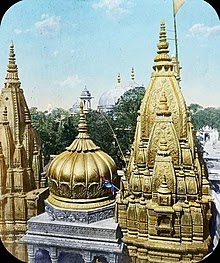Attributes
 |
| Shiva with Parvati. Shiva is depicted three-eyed, the Ganges flowing through his matted hair, wearing ornaments of serpents and a skull garland, covered in ashes, and seated on a tiger skin. |
 |
| A seated Shiva holds an axe and deer in his hands. |
· Third
eye: Shiva is often
depicted with a third eye, with which he burned Desire (Kama) to
ashes called "Tryambakam" (Sanskrit: त्र्यम्बकम् ), which occurs in many scriptural sources. In classical
Sanskrit, the word ambaka denotes "an eye", and in
the Mahabharata, Shiva is depicted as three-eyed, so this name is
sometimes translated as "having three eyes". However, in Vedic
Sanskrit, the word ambā or ambikā means
"mother", and this early meaning of the word is the basis for the
translation "three mothers". These three mother-goddesses who
are collectively called the Ambikās. Other related
translations have been based on the idea that the name actually refers to the
oblations given to Rudra, which according to some traditions were shared with
the goddess Ambikā.
· Crescent
moon: Shiva bears on his
head the crescent moon.Theepithet Candraśekhara (Sanskrit: चन्द्रशेखर "Having the moon as his crest"
– candra = "moon"; śekhara = "crest,
crown") refers to this feature. The placement of the moon on his head as a
standard iconographic feature dates to the period when Rudra rose to prominence
and became the major deity Rudra-Shiva. The origin of this linkage may be
due to the identification of the moon with Soma, and there is a hymn in the Rig
Veda where Soma and Rudra are jointly implored, and in later literature, Soma
and Rudra came to be identified with one another, as were Soma and the moon.
· Ashes: Shiva iconography shows his body covered
with ashes (bhasma, vibhuti). The ashes represent a reminder that all of
material existence is impermanent, comes to an end becoming ash, and the
pursuit of eternal soul and spiritual liberation is important.
· Matted
hair: Shiva's distinctive
hair style is noted in the epithets Jaṭin, "the one with
matted hair" and Kapardin, "endowed with matted hair” or
"wearing his hair wound in a braid in a shell-like (kaparda)
fashion". A kaparda is a cowrie shell, or a braid of hair in the form
of a shell, or, more generally, hair that is shaggy or curly.
· Blue
throatTheepithet Nīlakaṇtha (Sanskrit नीलकण्ठ; nīla =
"blue", kaṇtha = "throat"). Since
Shiva drank the Halahala poison churned up from the Samundra
Manthan to eliminate its destructive capacity. Shocked by his act, Parvati
squeezed his neck and stopped it in his neck to prevent it from spreading all
over the universe, supposed to be in Shiva's stomach. However the poison was so
potent that it changed the color of his neck to blue.
· Meditating
yogi: his iconography
often shows him in a Yoga pose, meditating, sometimes on a symbolic
Himalayan Mount Kailasha as the Lord of Yoga.
· Sacred
Ganga: The epithet Gangadhara,
"Bearer of the river Ganga " (Ganges). The Ganga flows from the
matted hair of Shiva. The Gaṅgā (Ganga), one of the major
rivers of the country, is said to have made her abode in Shiva's hair.
· Tiger
skin: Shiva is often shown
seated upon a tiger skin.
· Serpents: Shiva is often shown garlanded with a snake.
· Trident: Shiva typically carries a trident called Trishula. The
trident is a weapon or a symbol in different Hindu texts. As a symbol,
the Trishul represents Shiva's three aspects of "creator,
preserver and destroyer" or alternatively it represents the
equilibrium of three Gunas of "sattva, rajas and tamas".
· Drum: A small drum shaped like an hourglass is
known as a damaru. This is one of the attributes of Shiva in his
famous dancing representation known as Nataraja. A specific hand
gesture (mudra) called ḍamaru-hasta (Sanskrit for "ḍamaru-hand")
is used to hold the drum. This drum is particularly used as an emblem by
members of the Kāpālika sect.
· Axe (Parashu) and Deer are
held in Shiva's hands in Odisha & south Indian icons.
· Rosary
beads: he is garlanded with
or carries a string of rosary beads in his right hand, typically made of Rudraksha. This
symbolises grace, mendicant life and meditation.
· Nandī: Nandi, also known as "Nandin", is the name of
the bull that serves as Shiva's mount (Sanskrit: vahana). Shiva's
association with cattle is reflected in his name Paśupati, or Pashupati (Sanskrit:
पशुपति), translated by Sharma as "lord of cattle" and
by Kramrisch as "lord of animals", who notes that it is particularly
used as an epithet of Rudra.
· Mount Kailāsa: Mount Kailash in the Himalyas is
his traditional abode. In Hindu mythology, Mount Kailāsa is
conceived as resembling a Linga, representing the center of the universe.
· Gaṇa: The Gangas are attendants of Shiva and live in
Kailash. They are often referred to as the bhutaganas, or ghostly hosts, on
account of their nature. Generally benign, except when their lord is
transgressed against, they are often invoked to intercede with the lord on
behalf of the devotee. His son Ganesha was chosen as their leader by
Shiva, hence Ganesha's title gaṇa-īśa or gaṇa-pati,
"lord of the gaṇas".
· Varanasi: Varanasi (Benares) is considered to
be the city specially loved by Shiva, and is one of the holiest places of
pilgrimage in India. It is referred to, in religious contexts, as Kashi.
 |
| Kashi Vishwanath Temple |










No comments:
Post a Comment